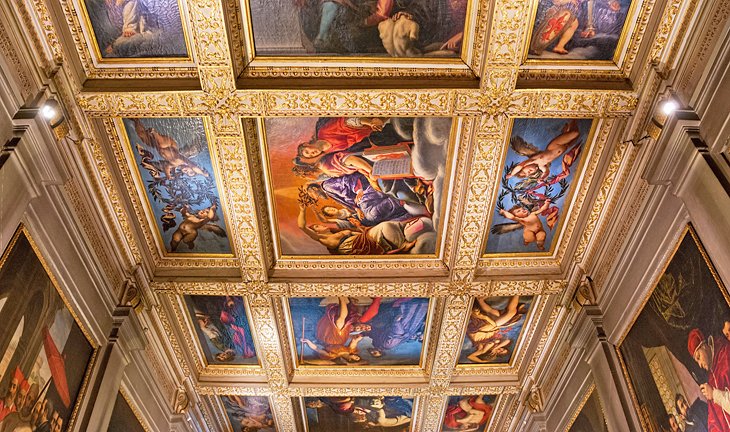
10 Best Museums in Florence, Italy
Share
As you might expect, the museums in Florence have among their collections the world's finest assemblage of Italian art of the Renaissance period, between about 1300 and 1500. After all, the Renaissance was born in Florence, forever changing the direction of Western art. And so its greatest artists thrived under the patronage of the Medici and other wealthy families.
So as you discover the highlights of these collections, expect to see plenty of Donatello, Ghiberti, della Robbia, and Botticelli. As well as two of the most famous of all Michelangelo's sculptures. But Florence's great art museums are not limited to the Florentine Renaissance; look for works by the great Venetians, Tintoretto, and Titian. As well as one of Raphael's finest portraits and paintings by Rembrandt, Velasquez, and Van Dyck.
Paintings and sculptures are not all you'll find. Look in Florence's museums for treasures as diverse as Egyptian mummies, historic fashions, an ancient chariot, and the Medici's jewelry.
In addition to the museums listed here, among Florence's tourist attractions are smaller specialized museums, ranging from a fascinating display of intricate mosaic art (Museo Opificio delle Pietre Dure) to those celebrating the designs of fashion giants Gucci and Ferragamo.
Along with the palaces that house formal art galleries – the Uffizi and Pitti Palace – the city's palaces are furnished in priceless art, and its churches often have museums of their own. This multitude of museums makes Florence one of the top places for art lovers to visit in Italy. Explore your options with our list of the top museums in Florence.
1. Uffizi Gallery

Conveniently arranged by periods. The Uffizi Gallery for all its size is a good way to get an overview of the tremendous changes the Renaissance brought in the way artists perceived and portrayed the world.
This chronological arrangement allows you to quickly sense the change of styles from the static. Begin with flat Byzantine representations of other-worldly madonnas and saints to more realistic and human portrayals. As well as works that include portraits, allegorical themes, even landscapes mixed with religious subjects. Next to seeing several contemporary artists' works together gives you the context for the Uffizi's famous block-busters. Such as Botticelli's Birth of Venus.
The Uffizi Museum's popularity requires timed tickets to control the flow of visitors. So that you can order these tickets ahead that takes you right past he lines at both of these attractions. And also assures that you will see the highlights and learn about their significance from an expert guide.
Exciting transformations are underway at the Uffizi! Renovations and brand new galleries are taking shape, meaning some artworks might have shifted their homes. To avoid any surprises, grab a fresh gallery plan before your visit.
2. Galleria dell'Accademia (Academy Gallery)

Founded in 1784 as a school for artists, the Accademia today holds an outstanding collection of works by Michelangelo. It is one of these, his David, that makes this museum well worth the long lines. Even though copies of the sculpture seem to be everywhere in the city. Beyond Michelangelo, the other galleries contain important works of Florentine artists from the 13th to the 16th centuries.
Also unfinished is the figure of St. Matthew, sculpted by Michelangelo in 1505 to 1506 and intended as one of 12 apostles for Santa Maria del Fiore Cathedral in Florence. A closer look reveals why David's marble slab differs from those of the surrounding slaves. This intentional flattening hints at the statue's placement – designed to stand proudly against a wall, captivating all eyes with its frontal grandeur.
At only 26, Michelangelo unleashed his visionary David upon the world. The sculpture's noble stance, a potent blend of pre-battle tension and serene resolve, stunned even his contemporaries with its perfection. Recognizing David's profound impact, the Accademia swiftly moved him within its walls in 1873, safeguarding him from the harsh elements. Later, in 1991, following a shocking attack, they further fortified his protection with a layer of sturdy glass. David became the symbol of the irrepressible spirit of liberty in Florence.
Highlights of the 15th-century works in the Sale Fiorentine are the Adimari Chest, with a grand wedding procession on the front, and a Madonna by Sandro Botticelli, from around 1470. The Sale Bizantine houses the oldest works of the collection, dating from the 13th and 14th centuries, including the important Crucifixion scene by Pacino di Bonaguida, Tree of Life (ca. 1310).
You can be sure of seeing Michelangelo's David and the other great works that combines these popular attractions and takes you right past the lines. Once inside, you can go straight to the most important works in each and learn about them from your guide.
Address: Via Ricasoli 58, Florence
3. Galleria Palatina - 3rd of 10 best Museum in Florence

It's not just the multiple works of Italian masters such as Titian, Tintoretto, Botticelli, Rubens, and Raphael that put the Palatine Gallery on the art map, or even the combination of these with works by Van Dyck and Velasquez.
Three other collections in the Pitti Palace include the Galleria d'Arte Moderna (Gallery of Modern Art); the Museum of Costume and Fashion; and the treasury, filled with gold and silver jewelry and other Medici treasures. Rather than a strict timeline, the Galleria Palatina weaves its artistic magic by integrating paintings. And also sculptures within the opulent tapestry of its richly adorned rooms.
Recover from the sensual overload of all this art by strolling through the adjoining Boboli Gardens and savoring the views across the city below, one of the favorite things to do in Florence.
4. Bargello Palace National Museum - One of the best Museum in Florence

Begun in 1859, Italy's first national museum outside the Vatican contains important works by 14th- to 16th-century Tuscan artists, particularly Donatello, the della Robbias, and Michelangelo. Four of his masterpieces are the focus of the rooms off the courtyard: a marble Brutus (ca. 1540); a relief of Madonna and Child with the young John the Baptist, a tondo carved about 1504; David (ca. 1531), also known as Little Apollo; and Michelangelo's first large sculpture Drunken Bacchus, (1497-1499).
The large 14th-century hall at the top shows works of Donatello, among them his St. George (1416), an early marble David, a later bronze one made in 1430, and St. John as a Child. Be sure to look for Brunelleschi's and Ghiberti's models for the competition for the north portal of the baptistery. Along with a room of ivory carvings, there's a collection of majolica and a room filled with enamels and gold work, for which Florence was famous in the Renaissance.
The top floor has one of the museum's highlights: two rooms of glazed terra-cotta by Andrea and Giovanni della Robbia. Along with the works of several masters, what distinguishes the Bargello is its attention to decorative arts and three-dimensional art.
Address: Via del Proconsolo 4, Florence
5. Museo dell'Opera di Santa Maria del Fiore (Cathedral Museum)

Priceless works of art given to Florence's cathedral are housed in the adjoining museum, along with originals of the more vulnerable works, such as Ghiberti's bronze door panels, brought indoors for safekeeping.
6. Museo Archeologico (Archeological Museum)

The best museum in Florence Italy was based on the extensive collections of Etruscan artifacts made by the Medici family. Other Medici and later collections added Egyptian, Greek, and Roman antiquities. Step into the captivating world of the Etruscans, where treasures abound. But amidst this archaeological feast, one section truly steals the spotlight: the Etruscan exhibits. Here, marvel at the bronze Chimera of Arezzo, a dazzling testament to Etruscan artistry. Which considered one of the finest examples of its kind.
Along with the Etruscan works are Greek and Roman bronzes. That is the most important of which are the Greek Idolino from the fifth century BC and the Horse's Head, a Greek bronze from the Roman period. Other museum highlights are Etruscan and medieval coins, as well as gold and silver work.
The Egyptian collection includes statues, ceramics, reliefs, sarcophagi, mummies. And also utensils from various Egyptian dynasties. Which including a very well-preserved wooden chariot from the time of Ramses I, 14th-century BC.
Address: Piazza SS Annunziata, Florence
Exploring the Museo Archeologico, a treasure trove of historical artifacts and ancient wonders in Rome. Also is a fascinating journey through Italy's rich past. To make your visit to this museum more convenient. Or you can consider transportation options like minibus hire Rome or mini bus hire Italy.
7. Bardini Museum - 7th of 10 best Museum in Florence

One of the most unusual museums in Florence was the private collection of artist and antiquarian Stefano Bardini. In the 1880s, Bardini bought several buildings, including a 13th-century church and 13th-century Palazzo Mozzi. Using these as a base, he created and decorated a building using medieval and Renaissance doors, windows, fireplaces, staircases, stonework, carved moldings, and coffered ceilings from palaces and churches that were being demolished.
The resulting villa, set above the city in a lovely sloping garden, was the showcase for his collections of priceless art and antiquities from various periods. A few of the highlights from among the more than 3,600 objects are works by Donatello, the Della Robbia brothers, Tintoretto, and a series of drawings by Tiepolo. Examples of 15th- to 17th-century Venetian and Tuscan woodwork are outstanding, as are the collections of musical instruments, ceramics, and antique furniture.
These are displayed among the sculptures, paintings, Roman sarcophagi, tapestries, 15th-century stuccoes, and polychrome wooden sculptures. It comes as a surprise to those tourists who have rubbed the shining nose of the bronze boar under the loggia of the Mercato Nuovo, known as the "Porcellino" to discover that it is a copy. The original is at Bardini Museum.
Address: Via dei Renai 37, Florence
8. Casa Buonarroti (Michelangelo House)

Once owned but not occupied by Michelangelo, this 16th-century house was made into a museum of Michelangelo's works and times by his heirs. Michelangelo Buonarroti the Younger, a highly cultured man of letters, conceived the idea of converting this house into a memorial and museum, and spared no expense in hiring the finest artists of the age to decorate it.
Address: Via Ghibellina 70, Florence
9. Museo Galileo

In Renaissance Florence, science was an art, and to the Medici and other Humanists, the two were inextricably entwined. You may agree when you see the artistry of some of the early scientific instruments gathered in this fascinating museum. You'll find globes, telescopes, meridians, sundials, and instruments for navigation.
Address: Piazza dei Giudici 1, Florence
10. Spedale degli Innocenti (Hospital of the Innocents)

The Hospital of the Innocents was among the first Renaissance buildings in Florence. It was designed by architect Filippo Brunelleschi, who built the dome of the cathedral, as a foundling hospital. Until 1875, mothers who wanted to leave their new-born babes anonymously in the care of the orphanage could put them in the "ruota," a revolving wooden cylinder at the end of the portico.
